Takeuchi Taijin's "A wolf loves pork" is a mind-boggling stop-motion animation piece created from hundreds, if not thousands, of printed photographs that traverse the walls and furniture of a one-room apartment.
[Link: A wolf loves pork.]
Takeuchi Taijin's "A wolf loves pork" is a mind-boggling stop-motion animation piece created from hundreds, if not thousands, of printed photographs that traverse the walls and furniture of a one-room apartment.
[Link: A wolf loves pork.]
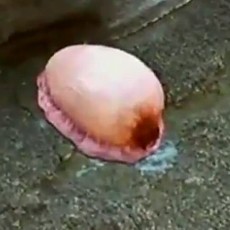
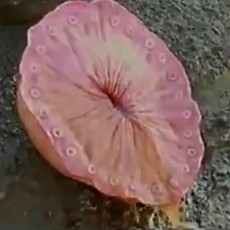
Here is some provocative video of a mysterious creature encountered by Japanese fishermen on a rocky seashore.
The excitement begins when the three men notice a group of strange animals on the side of a nearby cliff. Curious, they approach for a closer look and eventually manage to corner one. (The close encounter begins at 1:45 into the video.)
The slimy, pulsating beast -- like something out of a Cronenberg film -- appears to be some sort of amphibious sea animal that ventured ashore. After poking and prodding the creature with a stick and flipping it over to reveal an undulating, sphincter-like orifice, one of the men rashly -- and unwisely -- decides to give it a swig of his carbonated beverage. You don't want to miss the explosive conclusion.
Is this a bizarre new species? Alien creature? Spectacular hoax? You be the judge.
Enter the Jellyfish Fantasy Hall at Enoshima Aquarium south of Tokyo and you will find yourself surrounded by dazzling swarms of gently pulsating creatures. Here's a look at a few of the species on display there.
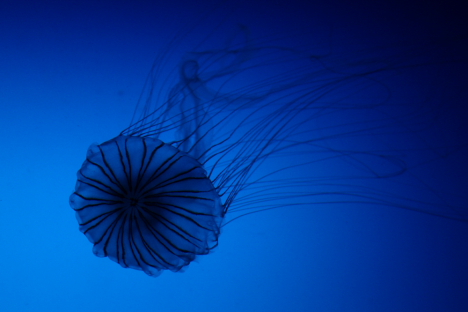
Japanese sea nettle [+]
Jellyfish, which have inhabited the world's oceans in one form or another for over one billion years, come in a dizzying array of shapes, sizes and colors. One species commonly found in Japanese coastal waters in spring and summer is the Japanese sea nettle (Chrysaora melanaster). When full grown, this jelly can reach up to 1 meter (3 ft) in length with an umbrella measuring 20 centimeters (8 in) in diameter.
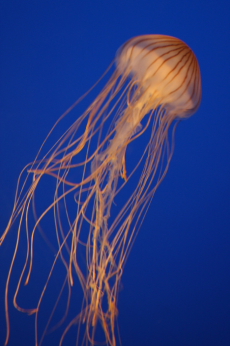
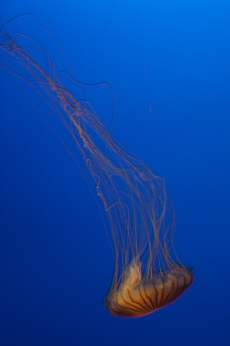
Japanese sea nettle [+] // [+]
The Japanese sea nettle has a relatively strong toxin. If dried and ground into powder, the toxin can irritate the eyes and nose when scattered on the wind. Ninja used to use this jellyfish powder as a weapon, and even today the jellyfish is known in Japan as hakushon-kurage ("sneeze jellyfish").
* * * * *
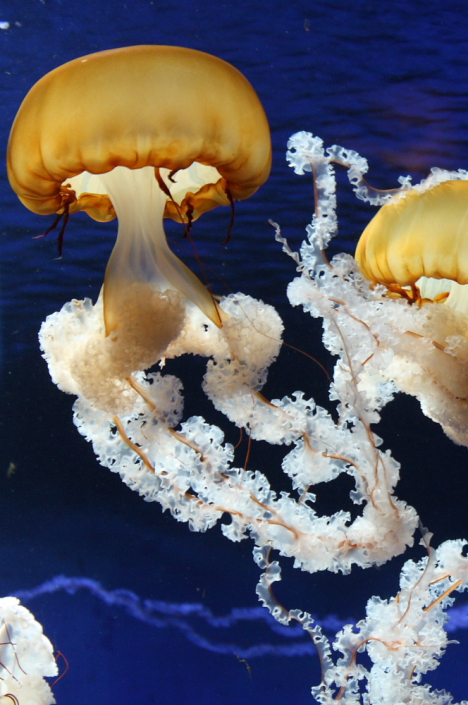
Pacific sea nettle [+]
The Pacific sea nettle (Chrysaora fuscescens) is one of the world's largest jellyfish, with an umbrella that typically measures up to 50 centimeters wide and tentacles that stretch up to 2 meters (6.5 ft) in length. It has a moderate to severe sting that can cause welts to form.
Found in the northwestern Pacific along the North American coast (and not in Japanese waters), this sea nettle has adapted to the cold California Current.
* * * * *
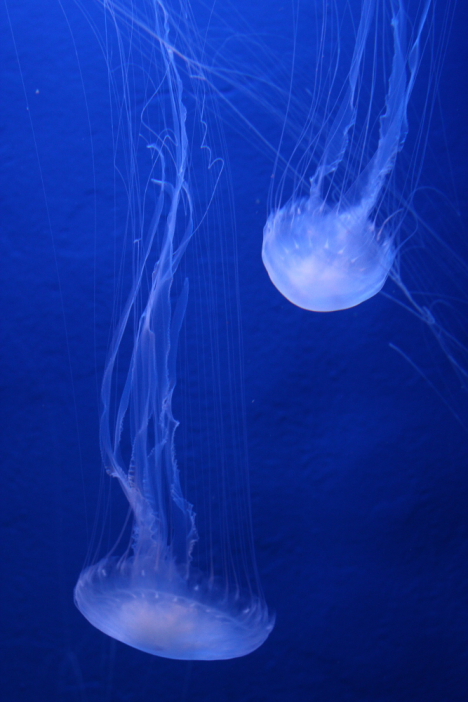
Atlantic sea nettle [+]
The Atlantic sea nettle (Chrysaora quinquecirrha) is found in the Atlantic along the North American coast, and like its Pacific cousin, this jelly can inflict a nasty sting. Its semi-transparent body makes it difficult to spot -- a problem both for beachgoers and for the sea nettle's prey.
* * * * *
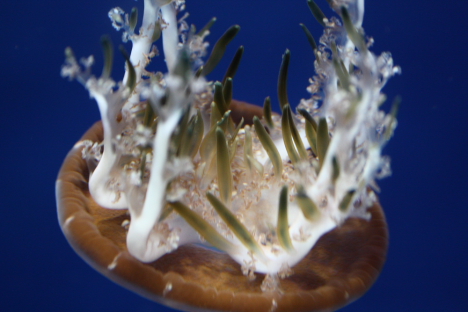
Upside-down jellyfish [+]
The upside-down jellyfish (Cassiopea sp.), which has an umbrella that typically grows to about 20 centimeters (8 in) in diameter, is found in shallow waters from the tropics to the subtropics.
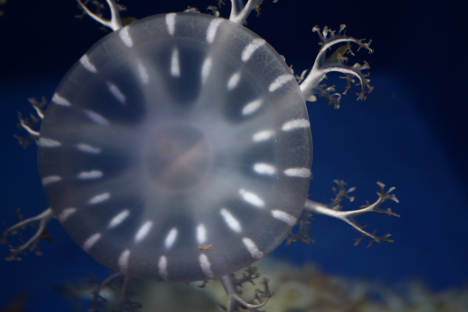
Upside-down jellyfish [+]
This jellyfish gets its name from the fact that it is usually seen upside-down on the sea floor, where it feeds on small plankton that drop down from above.
* * * * *
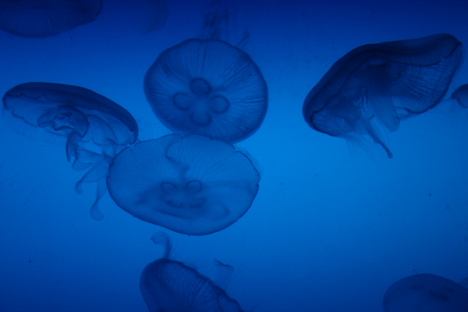
Moon jelly [+]
The moon jelly (Aurelia aurita) is probably the world's most widely distributed jellyfish. It is quite commonly found along the shores of Japan. Although it is composed of more than 95% water, it has an amazing ability to quickly heal itself, even after severe injuries. The moon jelly typically grows to a length of 15 centimeters (6 in) from the top of the umbrella to tip of the tentacles, with a diameter of 30 centimeters (1 ft).
* * * * *
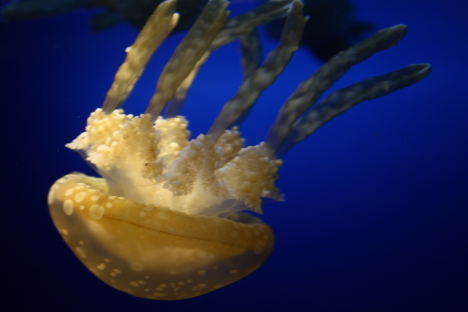
Spotted jellyfish [+]
The spotted jellyfish (Mastigias papua) has a brownish umbrella with white spots. With thick tentacles resembling the arms of an octopus, this creature is known in Japan as tako-kurage, or "octopus jellyfish." The spotted jellyfish gets its color from the algae that lives within its umbrella. This algae produces a type of sugar through photosynthesis that serves as a nutrient for this jellyfish.
Instead of one single mouth, the spotted jellyfish appears to have several smaller mouth openings in its oral arms.
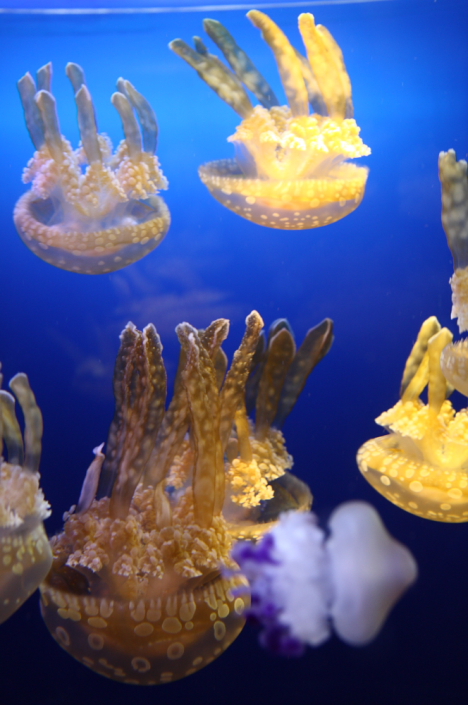
Spotted jellyfish [+]
Though mainly found in the southern Pacific Ocean, the spotted jellyfish is active in Japanese waters from summer to autumn. When full grown, this jellyfish measures about 50 centimeters (1 ft 8 in) from top to bottom and 15 centimeters (6 in) wide.
* * * * *
Other species found in the Jellyfish Fantasy Hall include the blue jellyfish (Catostylus mosaicus), brownbanded moon jelly (Aurelia limbata), and Amakusa jellyfish (Sanderia malayensis).

In the nearly two years since it was first unveiled to the world, the Child-robot with Biomimetic Body, or CB2, has been developing social skills by interacting with humans and watching their facial expressions, according to its creators at Osaka University.
Comprised of robotics engineers, brain specialists, psychologists and other experts, the research team has been teaching the android to think like a baby by having it evaluate facial expressions and classify them into basic categories, such as happiness and sadness.
The 130-centimter (4 ft 4 in) tall, 33-kilogram (73 lb) robot is equipped with eye cameras that record emotional expressions. Designed to learn like an infant, the robot can memorize facial expressions and match them with physical sensations, which it detects via 197 pressure sensors under a suit of soft, silicone skin.

In addition to watching faces, CB2 has been learning to walk. With 51 pneumatic "muscles," the little android can now amble through a room more smoothly than it could nearly two years ago, though it still requires the aid of a human.

Within two years, the researchers hope the robot will gain the intelligence of a two-year-old child and the ability to speak in basic sentences. In the coming decades, the researchers expect to develop a "robo species" that has learning abilities somewhere between those of humans and chimps.
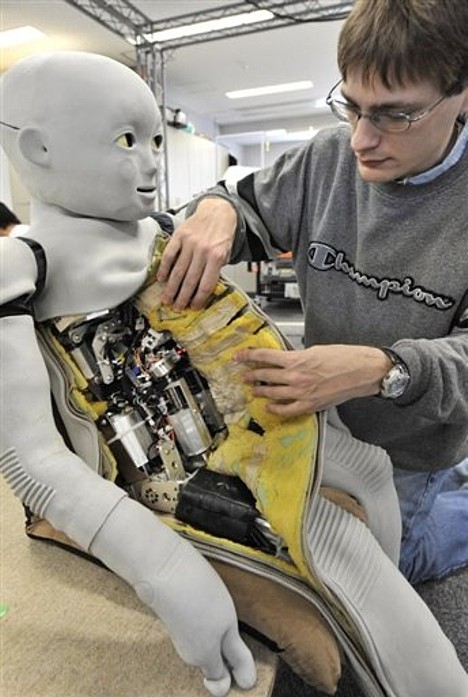
[Link: AFP]

A new online service developed by electronics giant NEC offers carbon-conscious households a fun and friendly way to keep tabs on their energy consumption, as well as that of their neighbors.
Developed in conjunction with major Internet provider BIGLOBE, the service -- called "Carbon Diet" -- includes an easy-to-install wifi-enabled device that attaches to the home circuit breaker and measures power consumption via electric current sensors. The collected data is then periodically transferred to the home computer using a ZigBee wireless link and sent to an online server for processing.
Users can log on to the Carbon Diet website to check their daily and hourly energy consumption and see how they rank in comparison with other participating households. Users can also see how their monthly carbon footprint compares with the same month of the previous year. Based on the degree to which users actually reduce their carbon emissions, they are awarded "eco-points" that can be exchanged for virtual soil, water, flowers and grass in a nature restoration simulation game.
Participants can also view their progress in the form of a game called "Carbon Ball," which features dung beetle avatars in a "carbon ball" rolling contest. The distance each household's dung beetle travels is based on how successful they are in reducing power consumption. The game is designed to instill a sense of competition to keep users motivated and focused on reducing energy consumption.
For now, the three-month trial service is being conducted in the homes of 100 NEC employees. After the trial, NEC and BIGLOBE will work with Ex Corporation (an urban and environmental planning and consulting firm) to analyze the data and develop business models for local governments and the private sector. The company is aiming for sales of 2 billion yen ($20 million) over the next 3 years.
Here's a fansub of "Salaryman Man," an animated short by Takashi Taniguchi about a salaryman superhero who battles an evil villain threatening to destroy a company president.
+ Video